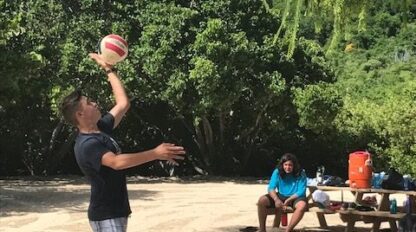3 Knots to Show Off to Friends

In our last edition on knotsmanship – 4- Knots Every Sailor Should Know. We took a look at the basics including the history and how to tie four of the most functional knots – the square knot, cleat hitch, clove hitch, and bowline. With a foundation established, it is now time to have a little fun as we consider 3 knots that will make your friends jealous- the Good-Luck-Knot, the Monkey’s Fist, and the Turk’s Head.
GOOD-LUCK-KNOT
The first of the three, the Good-Luck-Knot, is purely a decorative knot and has little practical use because it jams easily. It does, however, have a very interesting story that can be traced back to ancient China.
The shape of the knot, the square, is the symbol of the Earth – the great, solid reality. The cross, on the other hand, signified the abstract and spiritual. It was from this harmonious combination of these opposites, which is symbolized int he faces of the good luck knot, that good luck was said to arise. Here is a snazzy video to help walk you through how to tie a Good-Luck-Knot.
MONKEY’S FIST
 The second, and very popular knot, is the Monkey’s Fist. This knot can be used to weight the end of a heaving line, but is more commonly admired as a decorative knot. Though an apparently daunting knot, the monkey’s fist is fairly easy to tie with regular practice.
The second, and very popular knot, is the Monkey’s Fist. This knot can be used to weight the end of a heaving line, but is more commonly admired as a decorative knot. Though an apparently daunting knot, the monkey’s fist is fairly easy to tie with regular practice.
Start the monkey’s fist by making three full turns in the line as shown, then take the end and make a further three turns around and at right angles to the first three (1) and (2). Make sure that all the turns do not cross and that they remain in parallel. Now bring the end inside the first coil made and take another three turns round the second coil (3). Insert the end of the rope into the middle of the knot and start to pull all the turns tight, one after the other. Be patient, as the monkey’s fist takes some coordination and dexterity to get right.
TURK’S HEAD
 The third, and arguably most difficult, is the Turk’s Head. Though misleading, Turk’s Head actually refers to an entire family of knots rather than an individual knot. Again primarily a decorative knot, the Turk’s Head is often also used to make the lead spoke on the helm, indicating that the tiller is centered.
The third, and arguably most difficult, is the Turk’s Head. Though misleading, Turk’s Head actually refers to an entire family of knots rather than an individual knot. Again primarily a decorative knot, the Turk’s Head is often also used to make the lead spoke on the helm, indicating that the tiller is centered.
Note: thin line or leather lacing is ideal for tying this knot. Difficult to describe in writing, the pictorial and embedded video provide much clearer instructions for tying. To make the process clearer, the line last used is marked with ‘X’. The dotted line represents a continuation from where the previous picture left off.

